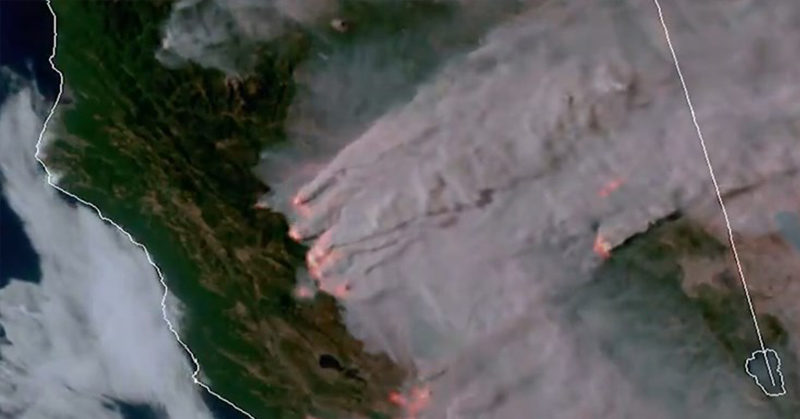In 2018, California experienced the deadliest and most destructive wildfire season on state record, with over 7500 fires burning over 1.5 million acres of land. Thousands of people lost their homes, and dozens lost their lives [1].
A little over a year later, Australia experienced a series of massive bushfires across the country, burning more than 27 million acres of land and killing thousands upon thousands of wildlife, as well as more than thirty people [2].
2020 is turning out to be an equally disastrous year for wildfires, as California again is battling hundreds of fires across the state in one of the worst wildfire seasons on record.
Read: Abandoned tanker could spill 4 times more oil than Exxon Valdez, U.N. official warns
A Recipe for a Wildfire
Currently, the second and third largest fires the state has ever experienced are burning in California, along with over five hundred other fires. Wildfires are an annual, natural occurrence, but not to this extent [3].
So what is making this year so bad? According to John Bailey, a fire ecologist at Oregon State University, it’s simply physics, and fires are not a new phenomenon.
In order for a wildfire to start, you need an interaction between three things: weather, climate, and fuels like dried-out grasses and plants. Dry weather combined with extremely hot temperatures are the perfect environment to start a wildfire, then all you need is a spark- enter lightning.
Since the late nineteenth century, temperatures in California have been rising. As the climate continues to get warmer, annual heat waves in the state are becoming increasingly intense. In the last few weeks California has experienced some of the hottest temperatures ever recorded on earth, which has dried up much of the vegetation across the region.
Finally last week a barrage of lightning from a tropical storm system, which caused over twelve thousand strikes across the state, ignited fires in mountain, chaparral, and desert regions. Recent aerial images of California show the state blanketed in dense smoke, which is a significant health concern and emits large amounts of carbon dioxide in the atmosphere [3].
Climate Change and Extreme Weather
Climate change has been a key factor in the increasing number and intensity of wildfires not only in the Western United States, but in many other regions of the world as well.
As explained earlier, arid, hot temperatures cause sources of forest fuel (like leaves, grasses, and sticks) to dry up, which increases the likelihood of a fire starting. Climate change has caused many regions in the Western US (most notable California) to become even hotter and drier than normal, leading to a one hundred percent increase in the number of forest fires since the mid-1980s [5].
The research shows that changes in climate that create these warmer, drier conditions lead to increased drought and a higher risk for a longer, more intense wildfire season. Projections for the Western United States show that an annual temperature increase of one-degree Celsius would lead to an increase in the median burned area per year by as much as six hundred percent in some types of forests [6].
Once a fire starts, hot and dry conditions make it easier for the fire to spread and harder to put out, which is why the wildfires are growing in size year after year. These forest fires in turn pump significant amounts of carbon dioxide into the air, contributing further to climate change and thus perpetuating the cycle [7].
California Wildfires: Destroying Homes, Forests
As of August 24, 2020, the wildfires in California have destroyed at least twelve thousand buildings, homes, and structures, and have taken the lives of seven people. The fires have displaced hundreds of thousands of people in the middle of a global health crisis, and the resulting smoke has forced millions indoors during a heatwave [8].
Parts of California’s famous wine country are now ablaze, and several of the state and national parks have been closed, with the extent of the damage as of yet unknown. According to Bailey, however, these natural areas will recover- its the man made structures like our campgrounds, historic sites, homes, and our lives, that will suffer.
“These systems have been programmed to respond [to wildfire] for millennia,” he said [4].
As the forest fires rage on, it is hard to say what will happen next- how soon they will stop, how many more will be forced to evacuate their homes, and what the future holds for America’s most populous state.
Keep Reading: Zebra Finches Sing to Their Eggs, and Scientists say This Might Help Their Babies Survive Climate Change
- https://www.fire.ca.gov/incidents/2018/
- https://www.bbc.com/news/world-australia-50951043
- https://mashable.com/article/california-fires-images-smoke-2020/
- https://mashable.com/feature/woolsey-fire-rains-photos-land-renewed-malibu-california/
- https://www.c2es.org/content/wildfires-and-climate-change/#:~:text=Climate%20change%20has%20been%20a,in%20the%20Western%20United%20States.&text=Research%20shows%20that%20changes%20in,these%20increases%20in%20wildfire%20risk.
- https://www.fs.fed.us/pnw/pubs/pnw_gtr870/pnw_gtr870.pdf
- https://www.pnas.org/content/113/42/11770.short
- https://www.theguardian.com/us-news/live/2020/aug/24/california-fires-evacuation-orders-bay-area-wildfires-latest-news-updates

